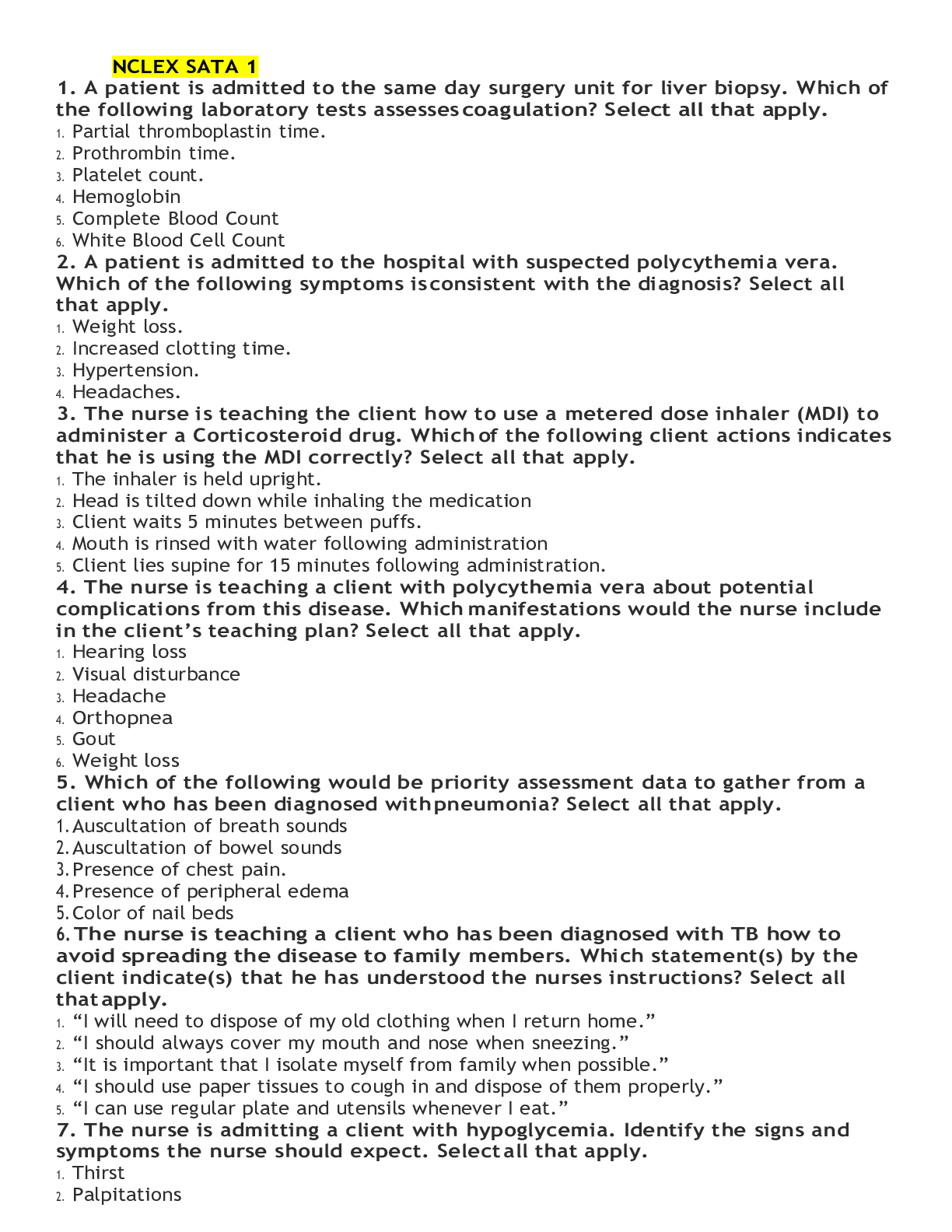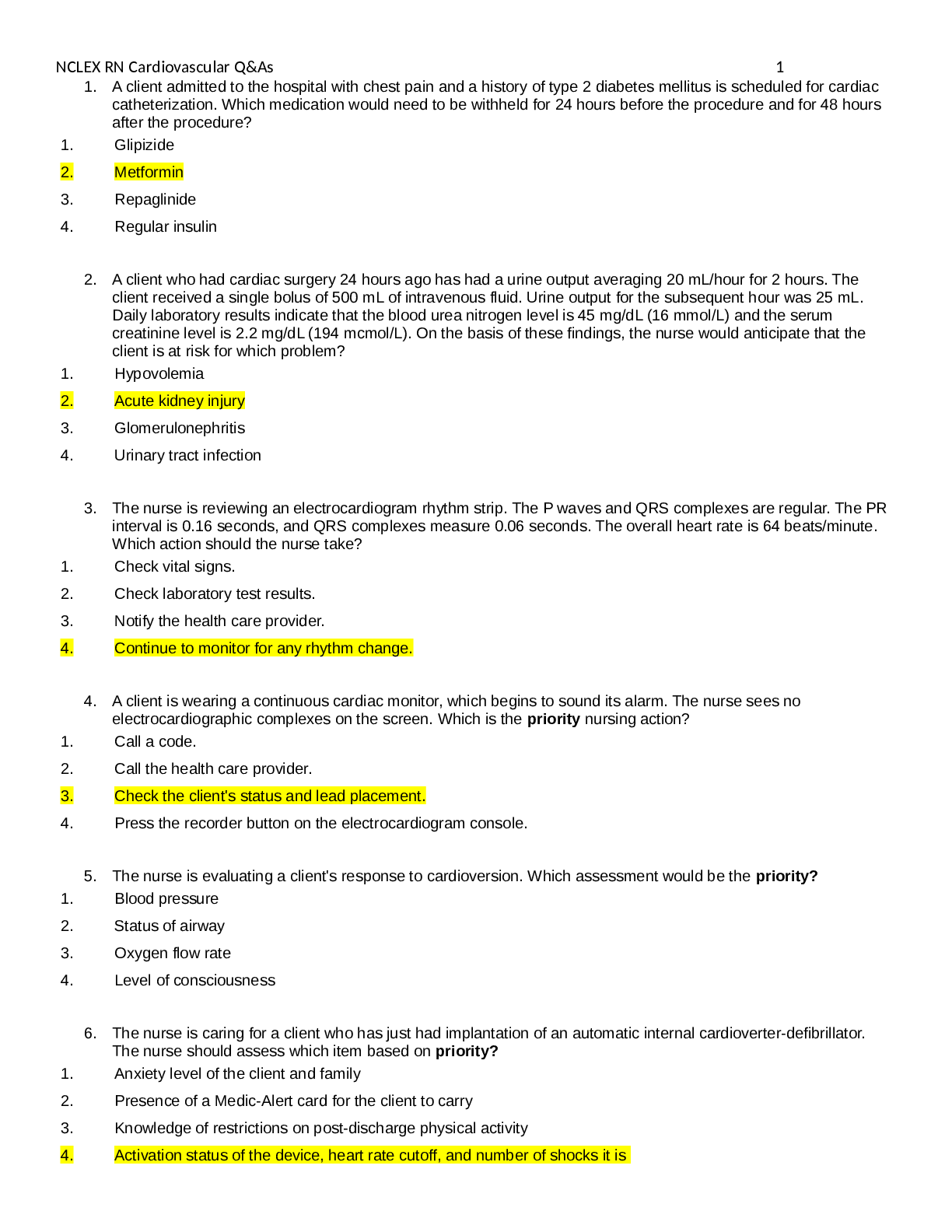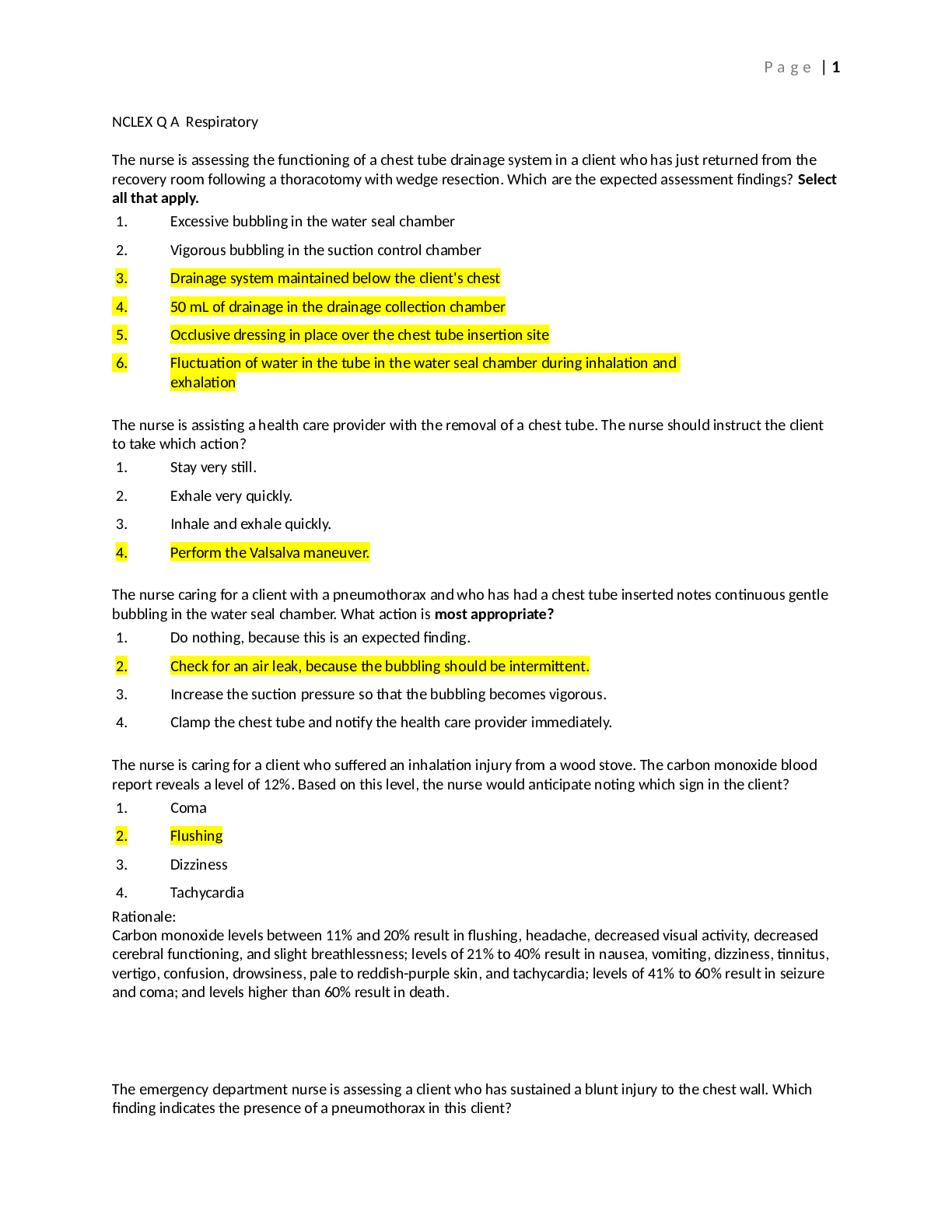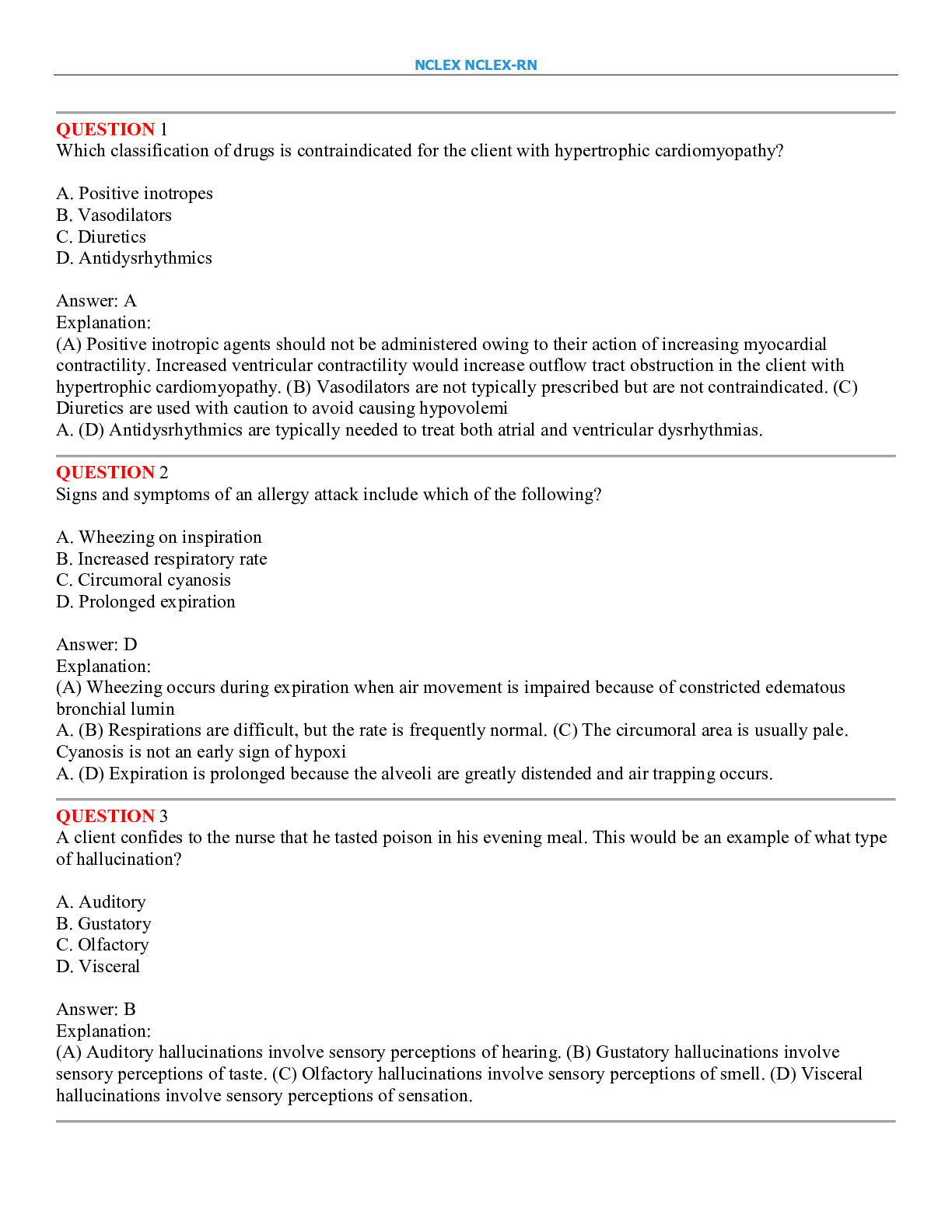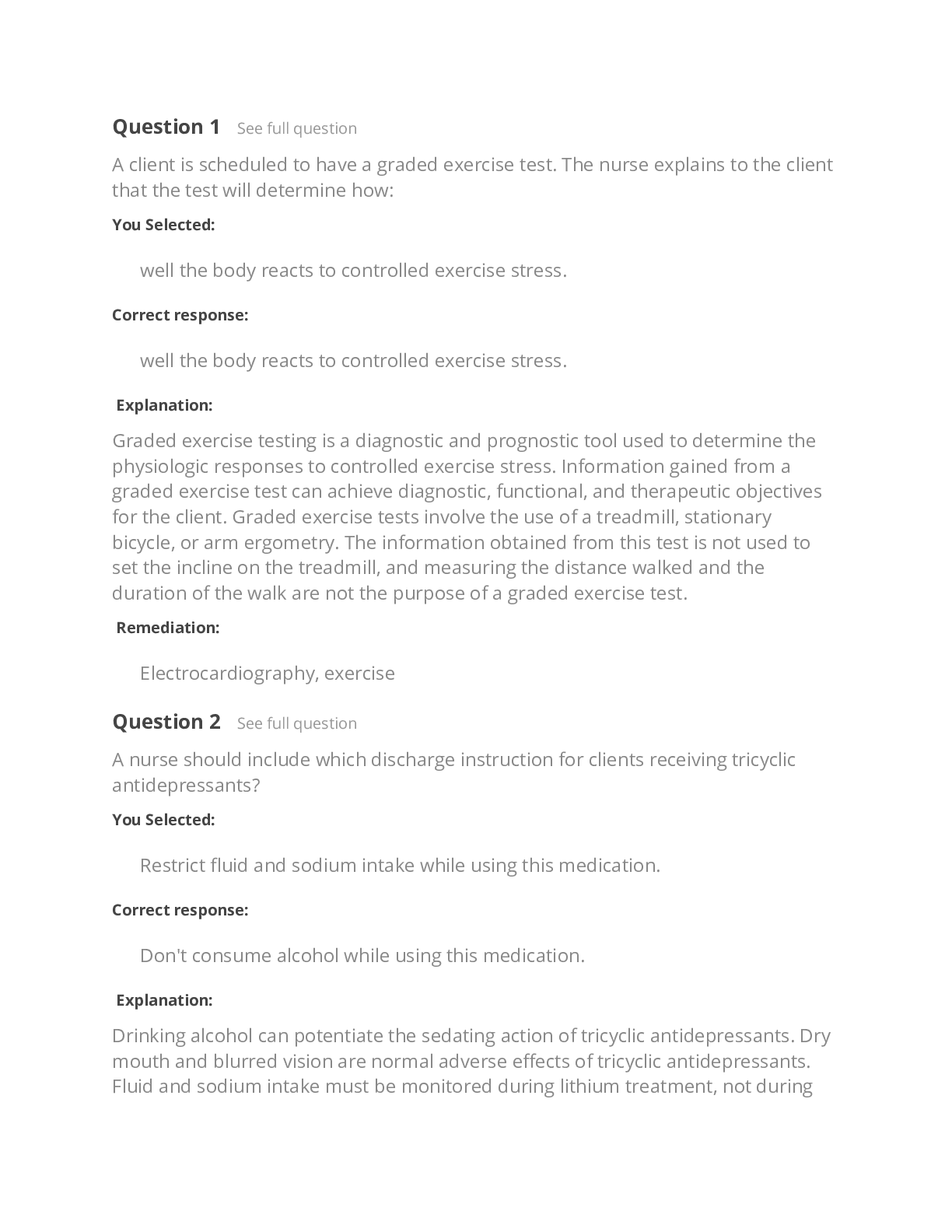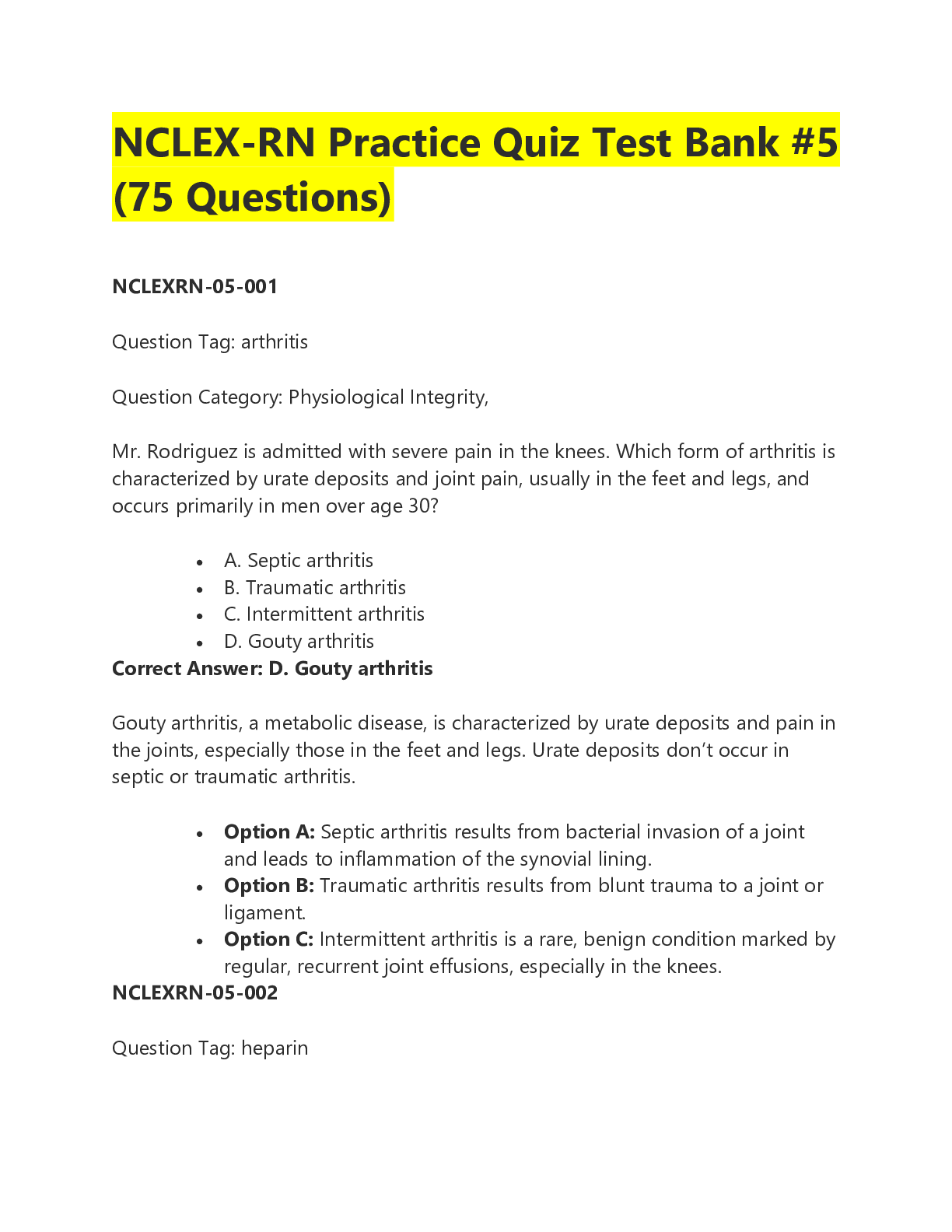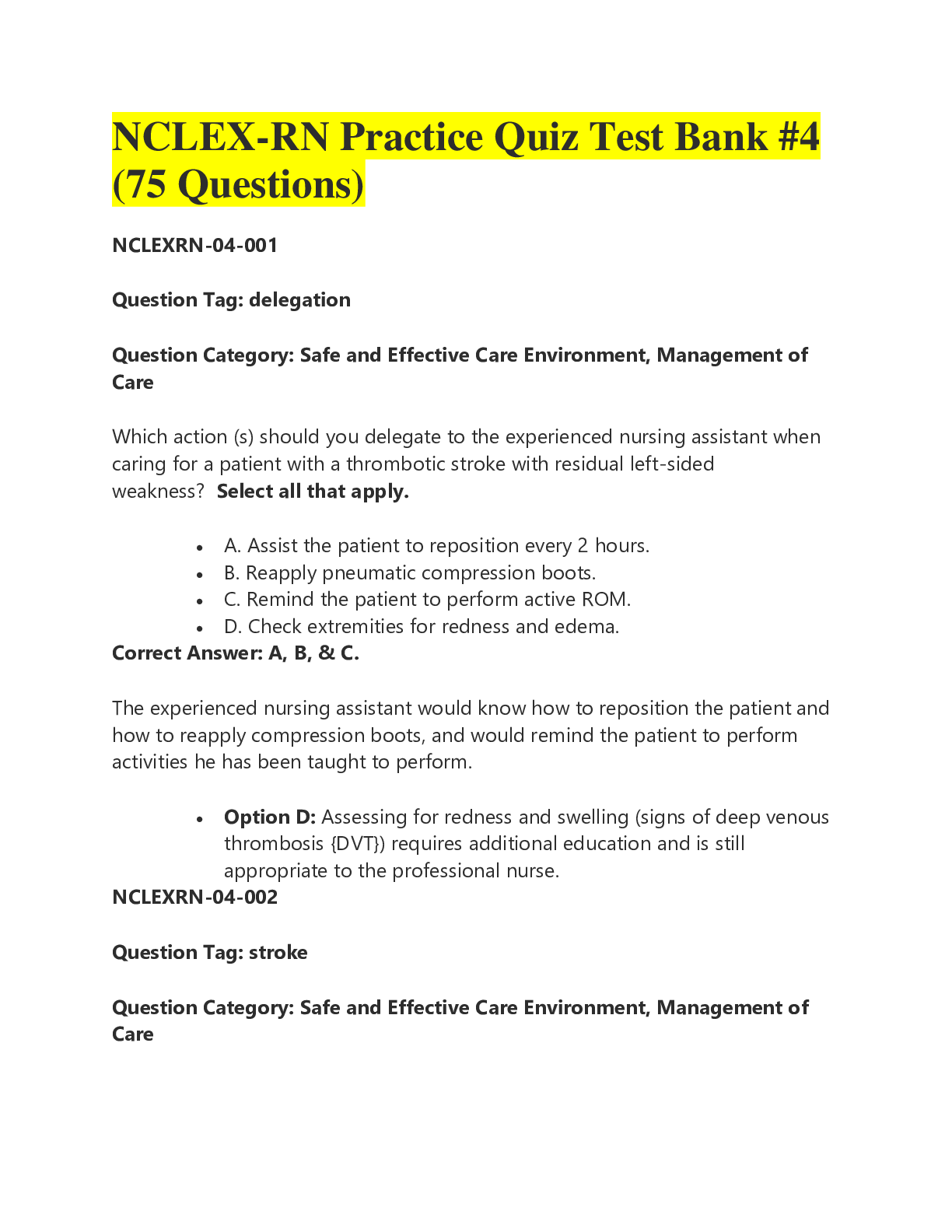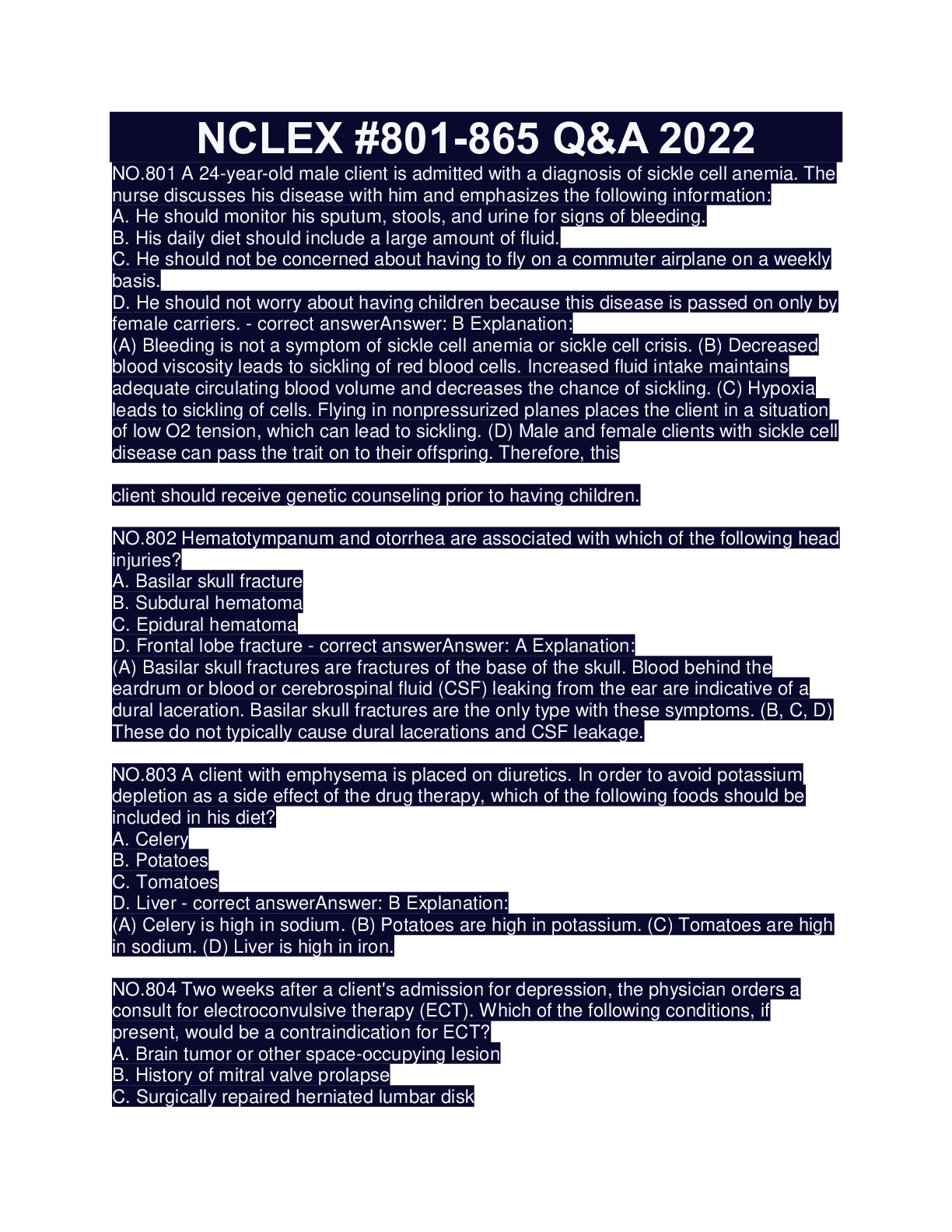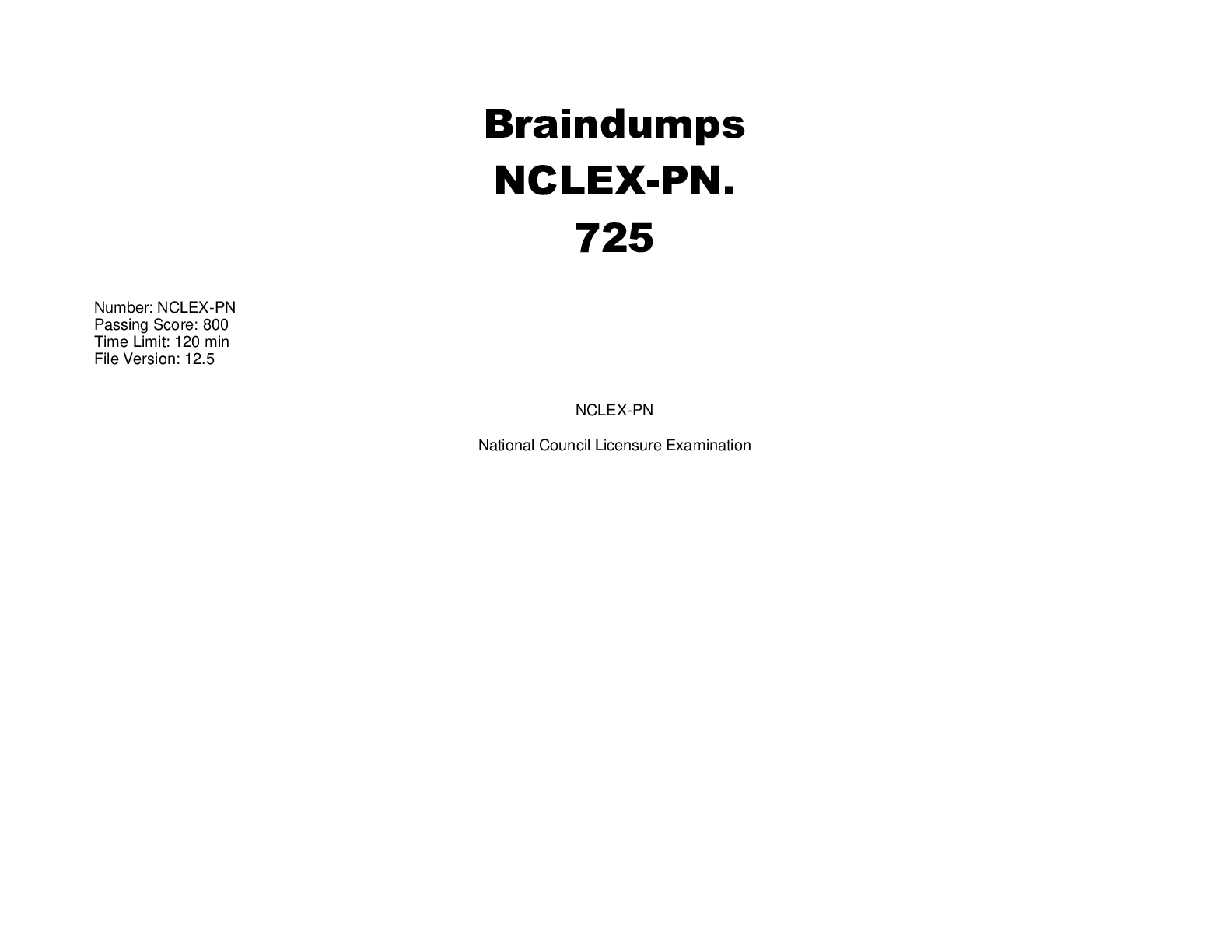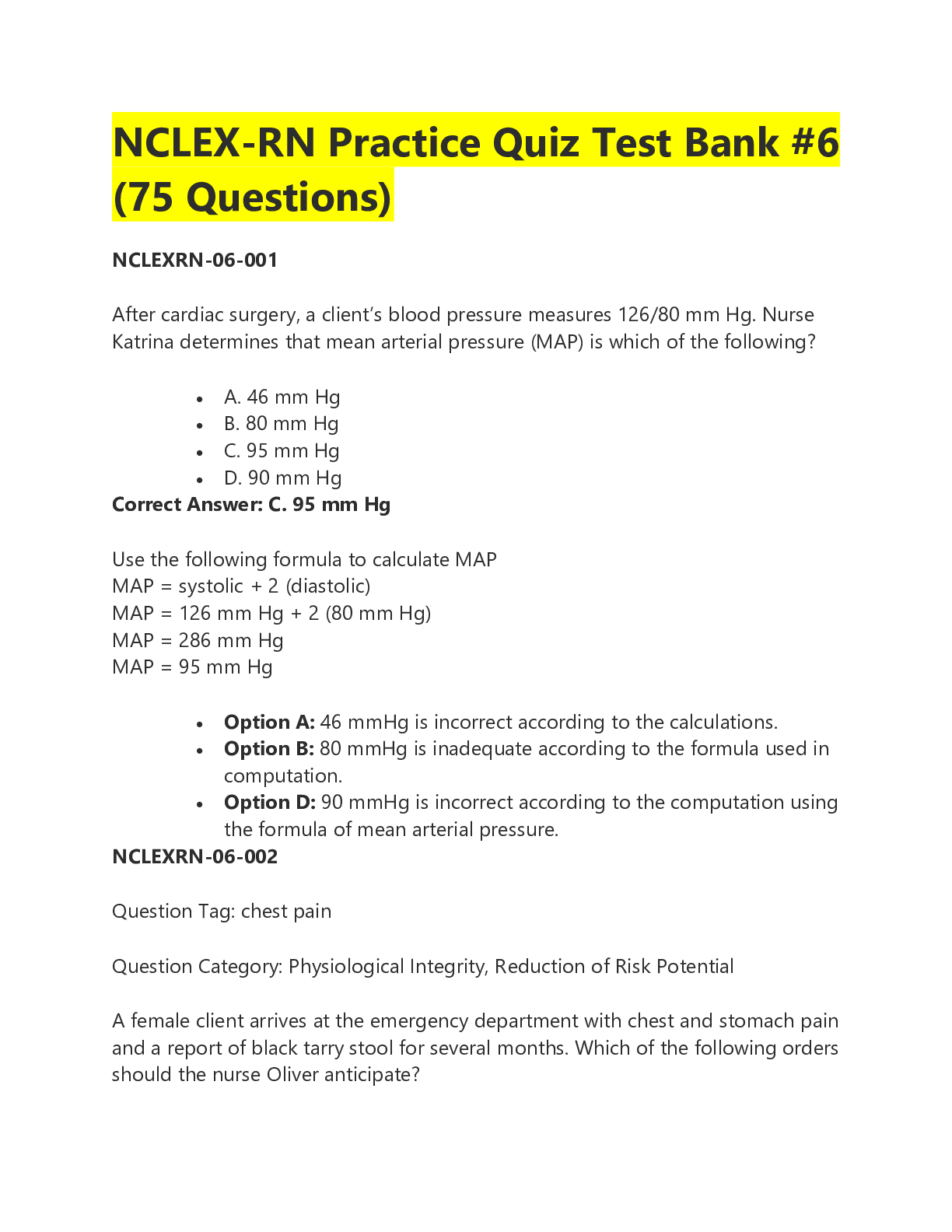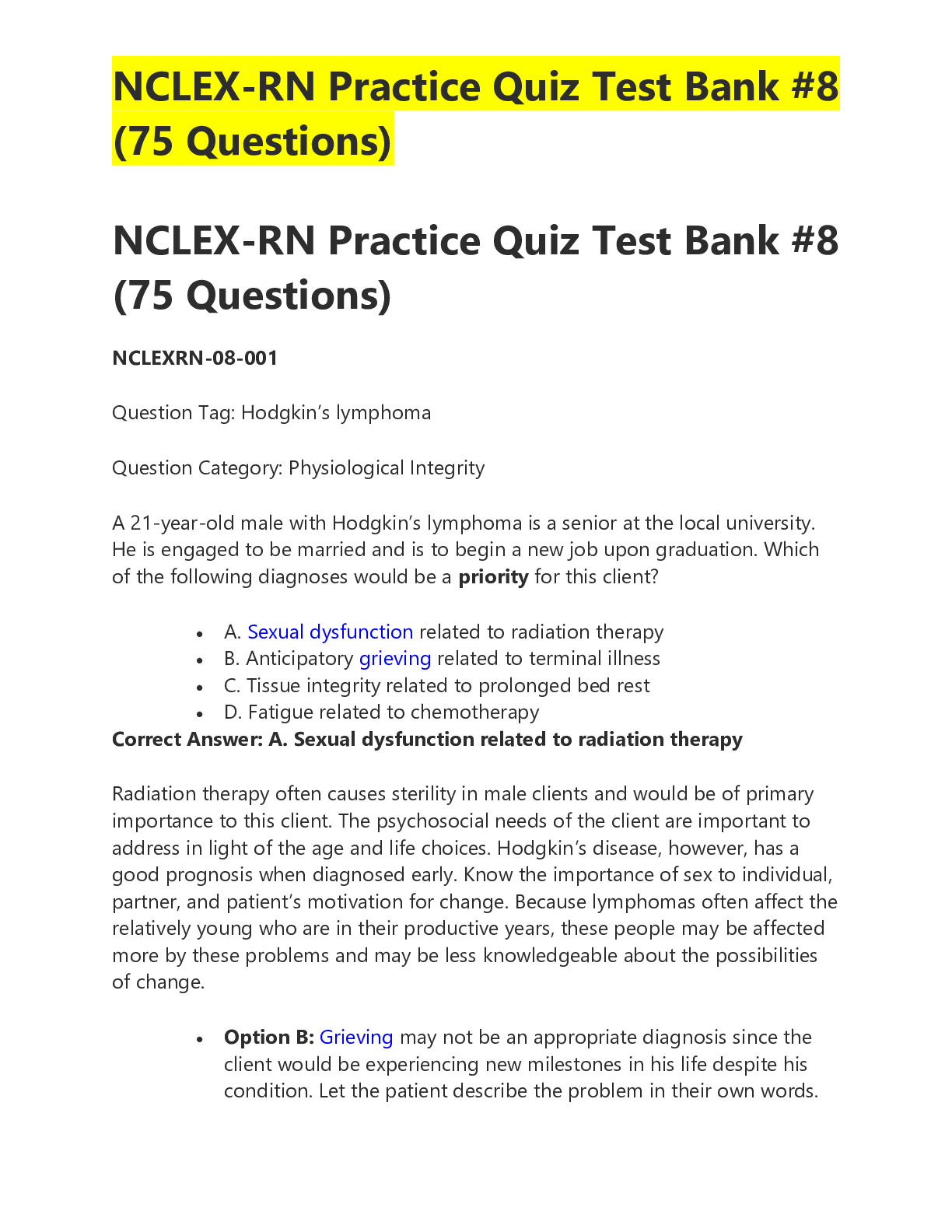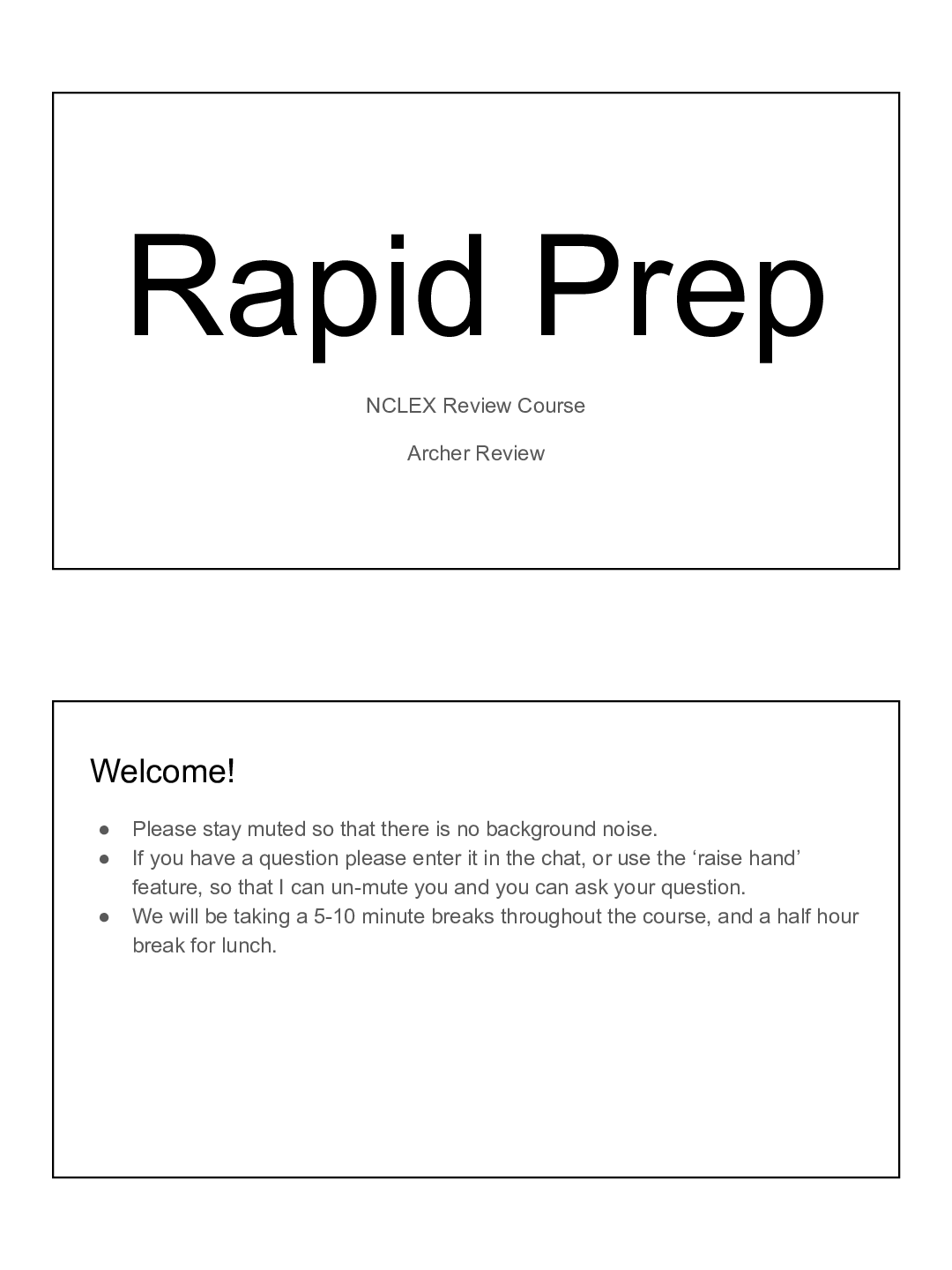NCLEX-RN Practice Quiz Test Bank #2 (75 Questions)
Document Content and Description Below
NCLEX-RN Practice Quiz Test Bank #2 (75 Questions) 1. 1. Question While assessing a one-month-old infant, which of the findings warrants further investigation by the nurse? Select all that apply. o A.... Abdominal respirations o B. Irregular breathing rate o C. Inspiratory grunt o D. Increased heart rate with crying o E. Nasal flaring o F. Cyanosis o G. Asymmetric chest movement Incorrect Correct Answers: C, E, F, & G • Option C. Grunting occurs when an infant attempts to maintain an adequate functional residual capacity in the face of poorly compliant lungs by partial glottic closure. As the infant prolongs the expiratory phase against this partially closed glottis, there is a prolonged and increased residual volume that maintains the airway opening and also an audible expiratory sound. • Option E: Nasal flaring occurs when the nostrils widen while breathing and is a sign of troubled breathing or respiratory distress. • Option F: Cyanosis refers to the bluish discoloration of the skin and indicates a decrease in oxygen attached to the red blood cells in the bloodstream. • Option G: Asymmetric chest movement occurs when the abnormal side of the lungs expands less and lags behind the normal side. This indicates respiratory distress. • Option A: Abdominal respiration is normal among infants and young children. Since their intercostal muscles are not yet fully developed, they use their abdominal muscles much more to pull the diaphragm down for breathing. • Option B: Newborns can have irregular breathing patterns ranging from 30 to 60 breaths per minute with short periods of apnea (15 seconds). • Option D: An increase in heart rate is normal for an infant during activity (including crying). Fluctuations in heart rate follow the changes in the newborn’s behavioral state – crying, movement, or wakefulness corresponds to an increase in heart rate. 2. 2. Question A nurse is to administer meperidine hydrochloride (Demerol) 100 mg, atropine sulfate (Atropisol) 0.4 mg, and promethazine hydrochloride (Phenergan) 50 mg IM to a preoperative client. List the order in which the nurse must carry out the following actions prior to the administration of preoperative medications. View Answers: • Place the call bell within reach • Instruct the client to remain in bed • Have the client empty bladder • Raise the side rails on the bed Incorrect Correct order is shown above. 4. Have the client empty the bladder. The first step in the process is to have the client void prior to administering the pre-operative medication. If the client does not have a catheter, it is important to empty the bladder before receiving preoperative medications to prevent bladder injury (especially in pelvic surgeries). Else, a straight catheter or an indwelling catheter may be ordered to ensure the bladder is empty. 5. Instruct the client to remain in bed. Preoperative medications can cause drowsiness and lightheadedness which may put the client at risk for injury. 6. Raise the side rails on the bed. Raising the side rails on the bed helps prevent accidental falls and injury when the client decides to get out of the bed without assistance. 7. Place the call bell within reach. Call bells should always be within the reach of a client. 3. 3. Question A 32-year-old pregnant woman comes to the clinic for her prenatal visit. The nurse gathers data about her obstetric history, which includes 3-year-old twins at home and a miscarriage 10 years ago at 12 weeks gestation. How would the nurse accurately document this information? Fill in the blanks. o Answer: Gravida (3) para (1) Incorrect Correct Answer: Gravida 3 para 1 Gravida is the number of confirmed pregnancies and each pregnancy is only counted one time, even if the pregnancy was a multiple gestation (i.e., twins, triplets). Para (parity) indicates the total number of pregnancies that have reached viability (20 weeks) regardless of whether the infants were born alive. Thus, for this woman, she is now pregnant, had 2 prior pregnancies, and 1 viable birth (twins). 4. 4. Question Which individual is at the greatest risk for developing hypertension? o A. 45-year-old African-American attorney o B. 60-year-old Asian-American shop owner o C. 40-year-old Caucasian nurse o D. 55-year-old Hispanic teacher Incorrect Correct Answer: A: 45-year-old African American attorney • Option A: African-Americans develop high blood pressure at younger ages than other groups in the US. Researchers have uncovered that African-Americans respond differently to hypertensive drugs than other groups of people. They are also found out to be more sensitive to salt, which increases the risk of developing hypertension. • Option B: The incidence of hypertension in Asian-Americans does not appear to be significantly higher than the general population, according to limited US data. • Option C: The racial disparity in hypertension and hypertension-related outcomes has been recognized for decades with African-Americans with greater risks than Caucasians. • Option D: Hypertension prevalence rates in Hispanics may vary by gender and country of origin. Hispanic Americans overall have relatively low levels of hypertension, despite elevated levels of diabetes and obesity. 5. 5. Question A 15-year-old female who ingested 15 tablets of maximum strength acetaminophen 45 minutes ago is rushed to the emergency department. Which of these orders should the nurse do first? • A. Gastric lavage • B. Administer acetylcysteine (Mucomyst) orally • C. Start an IV Dextrose 5% with 0.33% normal saline to keep the vein open • D. Have the patient drink activated charcoal mixed with water Incorrect Correct Answer: A. Gastric lavage • Option A: Acetaminophen overdose is extremely toxic to the liver causing hepatotoxicity. Early symptoms of hepatic damage include nausea, vomiting, abdominal pain, and diarrhea. If not treated immediately, hepatic necrosis occurs and may lead to death. Removing as much of the drug as possible is the first step in treatment for acetaminophen overdose, this is best done through gastric lavage. Gastric lavage (irrigation) and aspiration consist of flushing the stomach with fluids and then aspirating the fluid back out. This procedure is done in life-threatening cases such as acetaminophen toxicity and only if less than one (1) hour has occurred after ingestion. • Option B: The oral formulation of acetylcysteine is the drug of choice for the treatment of acetaminophen overdose but should be done after GI decontamination with activated charcoal. Liver damage is minimized by giving acetylcysteine (Mucomyst), the antidote for acetaminophen. Acetylcysteine reduces injury by substituting for depleted glutathione in the reaction that converts the toxic metabolite of acetaminophen to its nontoxic form. When given within 8 hours of acetaminophen toxicity, acetylcysteine is effective in preventing severe liver injury. It is administered orally or intravenously. • Option C: Intermittent IV infusion with Dextrose 5% may be considered for late-presenting or chronic ingestion. • Option D: Oral activated charcoal (AC) avidly adsorbs acetaminophen and may be administered if the patient presents within 1 hour after ingesting a potentially toxic dose. Charcoal should not be administered immediately before or with antidotes since it can effectively adsorb it and neutralize the benefits. 6. 6. Question Which complication of cardiac catheterization should the nurse monitor for in the initial 24 hours after the procedure? • A. Angina at rest • B. Thrombus formation • C. Dizziness • D. Falling blood pressure Incorrect Correct Answer: B. Thrombus formation A thrombus formation may prevent blood from flowing normally through the circulatory system, which may become an embolism, and block the flow of blood towards major organs in the body. • Option A: The reported incidence of myocardial infarction with angina at rest is less than 0.1%, and is mostly influenced by patient-related factors like the extent and severity of underlying cardiovascular-related diseases and technique-related factors. • Options C & D: A falling BP and dizziness occur along with hemorrhage of the insertion site which is associated with the first 12 hours after the procedure. 7. 7. Question A client is admitted to the emergency room with renal calculi and is complaining of moderate to severe flank pain and nausea. The client’s temperature is 100.8 degrees Fahrenheit. The priority nursing goal for this client is: • A. Maintain fluid and electrolyte balance • B. Control nausea • C. Manage pain • D. Prevent urinary tract infection Incorrect Correct Answer: C. Manage pain Managing pain is always a priority because it ultimately improves the quality of life. The cornerstone of ureteral colic management is analgesia, which can be achieved most expediently with parenteral narcotics or nonsteroidal anti-inflammatory drugs (NSAIDs). • Option A: IV hydration in the setting of acute renal colic is controversial. Whereas some authorities believe that IV fluids hasten the passage of the stone through the urogenital system, others express concern that additional hydrostatic pressure exacerbates the pain of renal colic. • Option B: Because nausea and vomiting frequently accompany acute renal colic, antiemetics often play a role in renal colic therapy. Several antiemetics have a sedating effect that is often helpful. • Option D: Overuse of the more effective antibiotic agents leaves only highly resistant bacteria, but failure to adequately treat a UTI complicated by an obstructing calculus can result in potentially life-threatening urosepsis and pyonephrosis. 8. 8. Question What would the nurse expect to see while assessing the growth of children during their school-age years? • A. Decreasing amounts of body fat and muscle mass • B. Little change in body appearance from year to year • C. Progressive height increase of 4 inches each year • D. Yearly weight gain of about 5.5 pounds per year Incorrect Correct Answer: D. Yearly weight gain of about 5.5 pounds per year School-age children gain about 5.5 pounds each year and increase about 2 inches in height. Between ages 2 to 10 years, a child will grow at a steady pace. • Option A: Decreasing amounts of body fat and muscle mass are common in toddlers. • Option B: A decrease in the change in body appearance occurs among young adults. • Option C: Growth spurts are common in school-age children, as are periods of slow growth. [Show More]
Last updated: 7 months ago
Preview 1 out of 66 pages
Instant download

Instant download
Also available in bundle (1)

NCLEX-RN Practice Quiz Test Bank SET 1-12 BUNDLE | (900 Questions in Total)
NCLEX-RN Practice Quiz Test Bank SET 1-12 BUNDLE | (900 Questions in Total)
By Ajay25 7 months ago
$50
12
Reviews( 0 )
Document information
Connected school, study & course
About the document
Uploaded On
Oct 12, 2023
Number of pages
66
Written in
Additional information
This document has been written for:
Uploaded
Oct 12, 2023
Downloads
0
Views
66


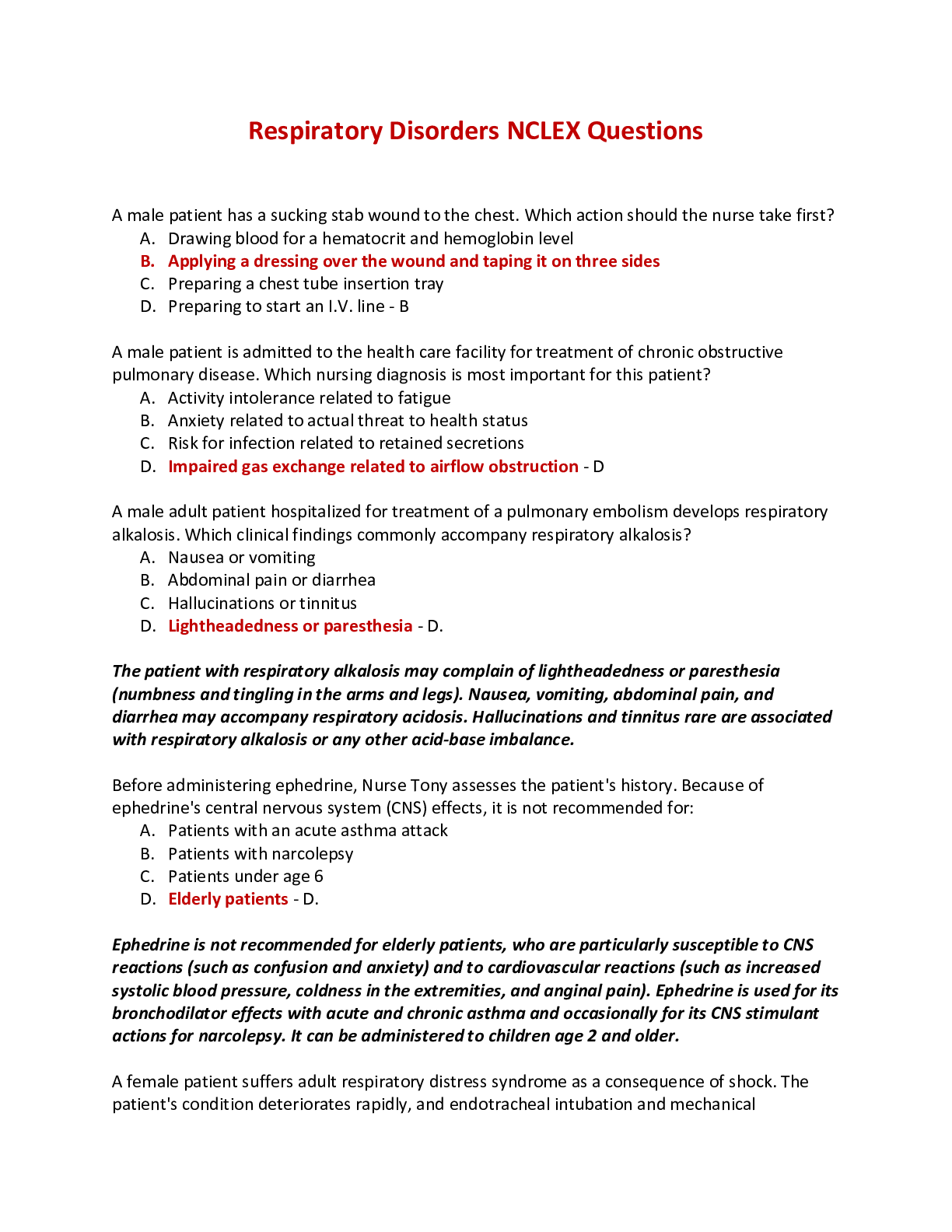
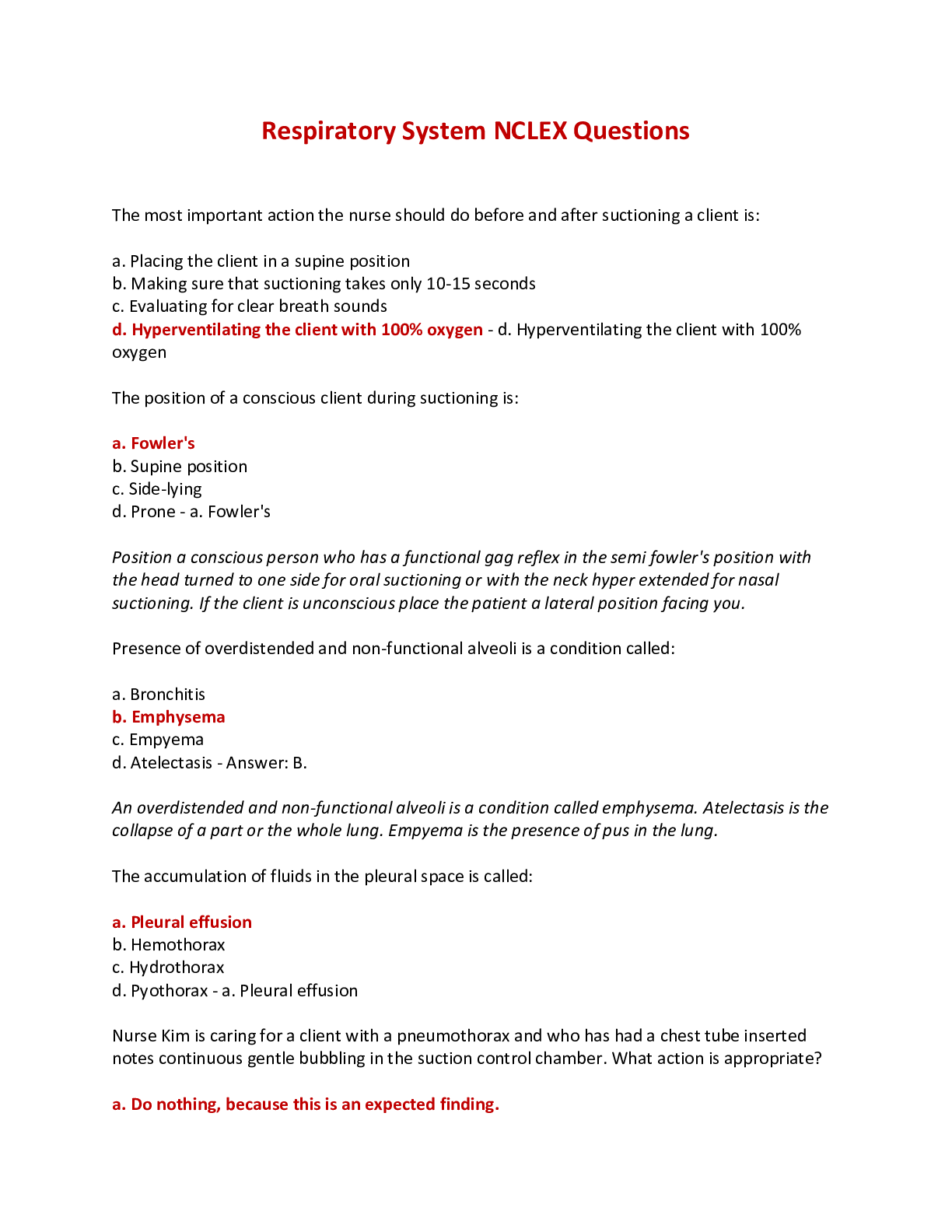
 NCLEX Study Guide.png)
